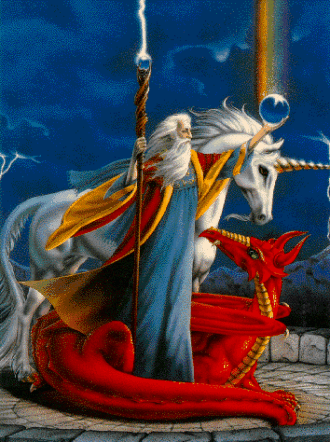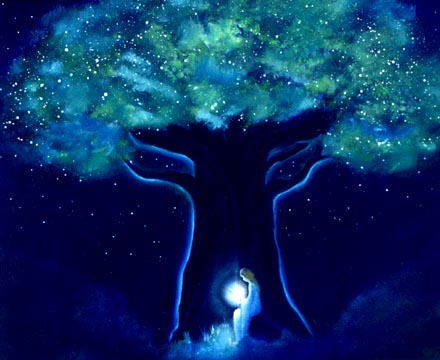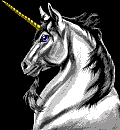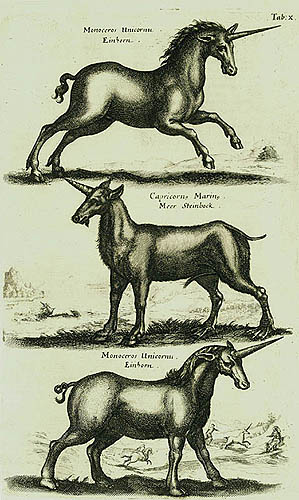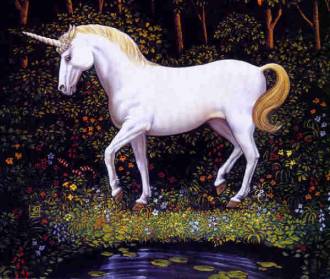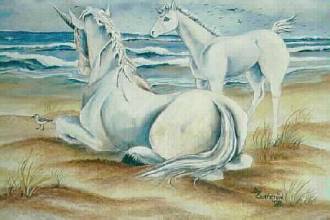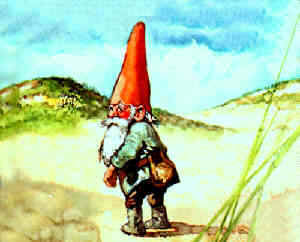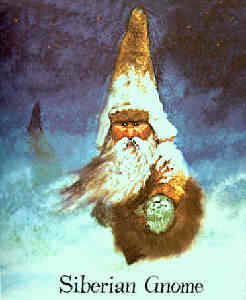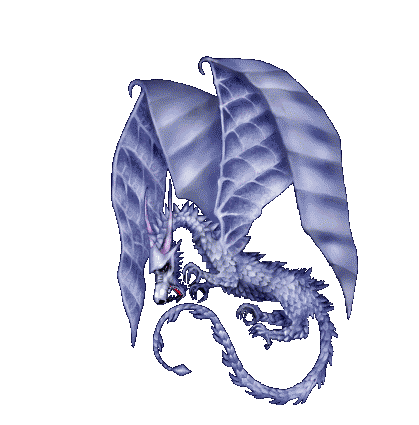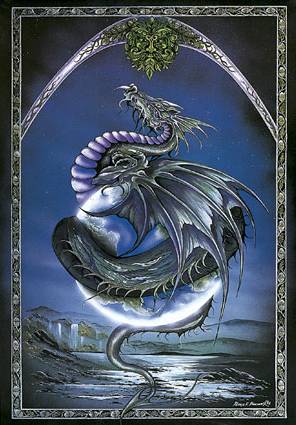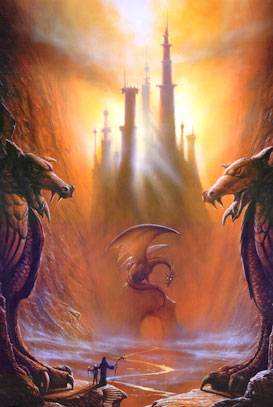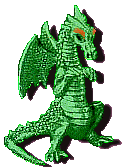|
 ' Faeries, Unicorns, Gnomes, and Dragons ' ' Faeries, Unicorns, Gnomes, and Dragons ' 

Fairies come in all shapes and sizes. Most often they are tiny, but they may also be eight or more feet tall, and can sometimes change their shape at will. Fairies often adopt semi-human form, and prefer to meddle in human affairs. They may use their magical powers to capture humans, to steal crops, or to bring bad luck. Other fairies are generous and helpful, bringing gifts or cleaning people's homes. Be careful--even the gentlest may become spiteful if provoked. Apart from the tiny fairy of legend, fairies include leprechauns, pixies, hobs, brownies, banshees, imps, goblins, bogeys, nature spirits, and many more. Their powers vary but most are more likely to harm than to help. In the Middle Ages, when everybody believed in fairies, the Church regarded them as fallen angels cast out by God, but continued to challenge His power. Many clergymen condemned fairies as demons and devils from Hell. Serious students of fairy belief say that the fairies are a folk memory of a prehistoric race of small people who once inhabited parts of France. Once conquered then forced into hiding, the small people may only have ventured out at night. To their conquerors, these little people continued to pose a powerful threat. Others trace the origins of fairies to the gods and spirits worshiped in primitive times. The ancient spirits of streams and groves are most certainly the direct ancestors of the nature spirit type of fairy. The word fairy is believed to derive from the Latin fata-the Fates, or goddess guardians of destiny. They were believed to preside over the cribs of the newly born just like those at the christening of Sleeping Beauty. Many poets have declared that behind the visible world are invisible chains and chains of conscious beings who are not of heaven but of earth with no inherent form but change according to their whim, or of the mind that sees them. Spirits of element are creatures who evolved in the kingdoms of the elements of air, earth, fire and water. They are called gnomes (earth), sylphs (air), salamanders (fire), and undines (water). Other elementals include: fairies, elves, leprechauns, dwarfs, trolls, kobolds, peris, devas, djins, sylvans, satyrs, fauns, brownies, nixies, pixies, and goblins. Garden Fairies are the most common kind of earth fairy. Gnomes are earth fairies that live in rocks. Nature Spirits are of the devic kingdom who care for the air, wind, fire and water, the growing of plants, and landscaping. Rock Fairies are sometimes called gnomes, and are found both above and below ground. Salamanders are known as fire fairies that inhabit the underground volcanic areas, and are involved with lightening and fires above ground. Sylphs are air fairies that are usually large in size compared to most fairies. Tree Spirits are larger than wood fairies and have a more physical body. Undines are water spirits that live in the ocean, or near streams, lakes or ponds. Water Babies are small, happy creatures found near the shore and near the surf. Certain times of the year are more favorable for spotting faeries: May Day (Beltane), Midsummer's Eve and Halloween (Samhain) are such times. Most often, young girls are vulnerable to faeries, and are given daisy chains and bells to ward off any danger from faeries.
|
The single horn of the unicorn indicates both virility and kingly power, and is also a sign of purity. From a book by Greek historian Ctesias c.398 B.C.E., the description was: "There are in India certain wild asses which are as large as horses, and larger. Their bodies are white, their heads dark read, and their eyes dark blue. They have a horn on the forehead which is about a foot and a half in length." The unicorn seems to be a mixture of the rhinoceros, the Himalayan antelope, and the wild ass. Its horn came to a long sharp point, to be white at the base, black in the center, and crimson at the tip. Ctesias claims that dust scraped from the horn was an antidote to poison, and that those who drank from the horn would be protected from convulsions and from poisoning. In the 17th and 18th centuries alicorn, a powder allegedly made from unicorn horn, was printed on the drug lists issued by the English Royal Society of Physicians. It was very expensive. The druggists explanation for the high costs was that unicorns were mostly caught in India, and the powder had to be shipped from there. The purifying nature of the unicorn's horn comes from a famous medieval legend. This story says that many animals gather at dusk by a pool to quench their thirst, but the water is poisoned and they are unable to drink. Soon they are joined by the unicorn who dips its horn into the water and cleanses it. Another famous medieval legend is the capture of the unicorn by a young female virgin. The unicorn, a small goat-like creature too fierce and swift to be captured by hunters, could only be tamed by a female virgin seated alone in a forest under a tree. Attracted by her perfume of chastity, the unicorn would approach and lay its head in her lap. She would stroke its horn and lull it to sleep. Then she would betray the animal by cutting off its horn, and hand it over to the hunters.
Unicorns having a horse-like appearance is a recent occurrence. The use of horses, with horns added, in movies has perpetuated this concept, as in the movie "Legend", where the beautiful Andalusians were used. Historically, they have appeared goat-like or deer-like. This is evident in the famed Unicorn Tapestries and other Medieval art works that depicted Unicorns. Can a creature that has such world wide acceptance and recognition, be only a fictional being? How could it?! In all its incarnations, it is a creature of goodness and luck. A stand against evil and the dark, again, as in the movie "Legend", how can they be so universally recognized and not exist?
The true horn, when thrown into water, sends up little bubbles. The water seems to boil, though cold, and one can hear the boiling. The true horn gives out a sweet odor when burned. Poisonous plants and animals, when brought near the true horn, burst and die. The true horn sweats in the presence of poison. The true horn is always striated, is extremely hard, very heavy, the color of boxwood, and able to save the life of a pigeon poisoned with arsenic. Enclose a spider in a circle drawn on the floor with an alicorn. If the horn is true the spider will not be able to cross outside of the circle and will starve to death inside it. Place the horn in a vessel and with it three or four live and large scorpions, keeping the vessel covered. If four hours later the scorpions are dead, or almost lifeless, the alicorn is a true one. |
Males indulge in pipe-smoking Males think of marriage at about the age of 200 years
Greetings, farewells and goodnights are expressed by rubbing noses. Gnomes are 7 times as strong as a man. Urine can be contained for a whole day Brain capacity larger than man's. Hair grays very early, baldness unknown.
Not tone deaf, with fingertips as sensitive as those of a blind person. Fingerprints are mainly of a circular pattern. Heart attacks are unknown to them. Capable of smelling 19 times better than man. Sense of direction (as good as a homing pigeon) ESP...(Nonverbal communication over great distances) Weather forecasting
Pregnancy lasts 12 months Girl children are raised by their mothers and neighbor women in homely arts.
Boys at age 75 years are introduced to the members of the Regional Council, a few of them he may already know. Gnomes love to dance and always finding a reason occasion to celebrate.
- Woodland, Dune, Garden, House, Farm, and Siberian -
The adult female gnome weighs 250 - 275 grams...
|
In 1683 to 1691 Eberhard Werner HAPPEL published his Relations Curisosae, a collection of curiosities. There he commented on events of the day and reported stories from exotic countries, he presented scientific discoveries of various disciplines as well as descriptions of landscapes, their inhabitants and folk lore. The book gained such popularity that during the ensuing decades faked editions and sequels were issued. Of course HAPPEL could not ignore the dragon. He first presents the story of Deodatus de Gozon, a young knight of St. John who killed a dragon on the isle of Rhodes in 1345. HAPPEL afterwards lists some well-known facts: Dragons are many fold - some possess wings and others don't, some have four and others two legs. Their feet could be compared to those of goose, lions or eagles, but all dragons are said to be venomous. But then he suddenly states that they are monsters or miraculous creatures which could not spring from an ordinary copulation of two common animals of different species. (Of course he mentioned the mule as an example of such a bastard). And he gives the explanation: It is well accepted that dragons inhabit the remotest dwellings such as caves, cliffs or deserts. Only eagles, vultures and other birds of prey are their companions. In fact they dwelled there even before the dragon. To these places they brought their prey - snakes, birds, rabbits, lambs, dogs, and even little children! - To lacerate and devour them. And there the remains decayed. But still remnants of the semen of these unlucky victims survived. Of course it was impossible that this seed could develop ordinary animals. But through time the semen of various creatures would intermingle and at last a kind of "fermentation putrefaction" would give birth to a dragon. Logically, this dragon will show features of all animals involved: head and tail of the snake, wings of a bird or bat, ears of a rabbit and legs of whatever kind of being.
With Western Christian tradition the dragon became synonymous with evil, and the killing came to symbolize not merely the end of the year, but also the victory of God over the Devil. The slaying of the dragon, for this reason, has been associated with many Christian saints as, George of Lydda who slew a dragon in the name of God to convert pagans to Christianity. This struggle with the dragon has been interpreted as symbolizing our own internal struggle between deep-seated lusts and unconscious drives, and the demands of the conscience. While the West took the dragon to symbolize evil, the East portrayed it as life-giving and benevolent. This mystery lent itself to interpretation by symbols that made them easier to understand. To make them more powerful than humans, our ancestors may have conceived of dragons as a mixture of different creatures to suggest supernatural powers. Just as different people interpreted the character of dragons to fulfill their own needs, they concocted the appearance of the dragon from the beasts they found most significant. In the 2nd-century dragons were linked with guarding treasures. This link between dragons and treasure, and the caves where treasure was usually hidden, is found in many legends. In many other legends the heroes gain new kinds of power from killing the dragon. History is so rich and diverse with heroic fantasy that we should wonder if the dragon is really the evil beast portrayed by God-fearing Christians. Maybe, the dragon is really a gentle creature named Puff, and maybe it lives by the sea in a land called Honeli.
|
|

Need a Website? We can build you one!
|



